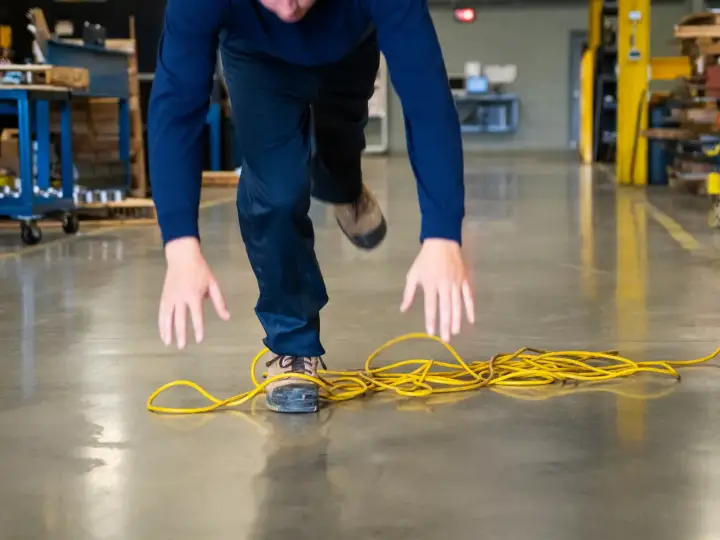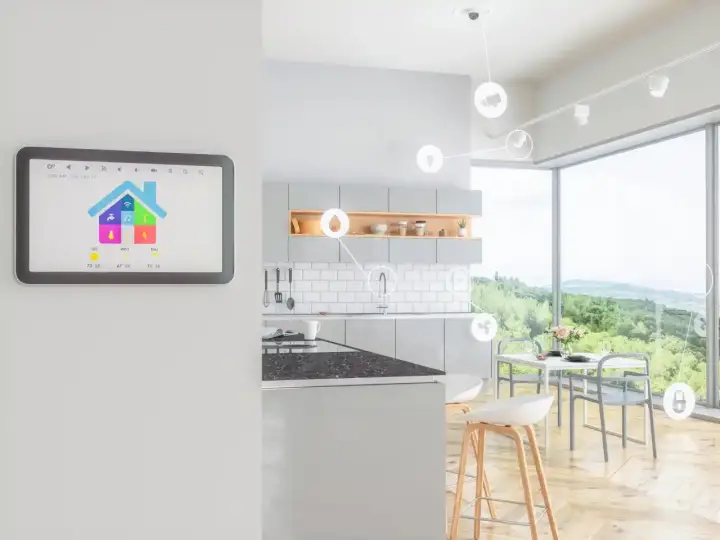7 Awesome Tips for Keeping Your Smart Home Absolutely Tidy And Beautiful
Updated on 9th May 2021 18:40 in DIY, General, Smart
You're probably here because you want to build a smart home but are concerned about how they can mess with our aesthetics. Maybe you've already got a smart home and are looking for ways to keep it tidy. In either case, the concern is real because many devices have a look that doesn't quite fit with your existing decorations. While the extent to which you will keep everything hidden depends greatly on your ecosystem, most of these tips will work with all platforms.

Disclaimer: This post contains affiliate links. As an Amazon Associate, I earn from qualifying purchases.
Table of Contents
Warning: some of the tips in this article involve drilling in your walls, which can be dangerous if done in the wrong way. Never attempt to do anything you aren't comfortable with, and always get a professional if you aren't sure what to do.
Keeping wires out of sight
It's no secret that all smart devices require electricity to run. Usually, this is provided either by a cable that plugs into the wall or with a small battery inside the device. Wires can also be used for communication between one or multiple devices. USB and Ethernet are good examples of connections that use wires. The point is, the chance is pretty high that any device you want to use will have at least one wire. Technology for communicating wirelessly has evolved to the point that we can expect most smart devices to use something like WiFi, Zigbee, Z-Wave, or Thread.
Despite these advancements, wireless power transmission is still a dream for virtually every practical situation. That's why you will see devices that either have some kind of battery or that plug into the wall with a cable. The easiest way to hide wires is not to have any, which is why a fully wireless device might be interesting to you. Unfortunately, they always come with a drawback that is usually in the form of reduced battery life or inferior functionality.
The short of it is that transmitting data wirelessly is a very energy-demanding task, making it difficult to do with a device that uses battery power. Some protocols, like Z-Wave or Zigbee, are specially designed to consume very little power during normal operation, which is why they are used for smart homes. Other protocols, like WiFi, use a significant amount of energy and are usually not used for this precise reason. In either case, making products wireless comes with extra cost, complexity, and consequences for the possible feature set. All of this is why many devices still have a power cord.
Sometimes, you just can't avoid wires. Maybe the device uses too much power, or maybe it's too large to reasonably spend time making it wireless. In any case, there are still ways to keep things tidy with wires.
Tip #1 - Taping down the wires
Even without the visual aspect, you will definitely want to tape down all exposed wires. While they certainly make things look messy, they can also become a safety hazard for animals, small children, or even adults that aren't familiar with your setup. As such, it's crucial to keep all your wires taped down to the surface they are travelling across. Especially if they are on the floor! The trip hazard is genuine, and you will be cursing yourself if you or someone else ever gets hurt because of them.
You can tape them down to the floor, the inside of a cabinet, the inside of a drawer, and any other location that is discrete. The most important part is to minimize the amount of slack the cable has. This will both result in a prettier finish and be safer for anyone that might trip on it otherwise. Ever notice that virtually every new house comes with wires that are safely tucked away into hard to reach areas? That's because any exposed cable becomes a risk both to safety and your eyes. You can even help it fit better by using tape that is the same color and pattern as your furniture.

Tip #2 - Using cable raceways
You may not be familiar with the term, but you've almost certainly seen these used before. Cable raceways are a staple of any professional renovation work. They mount onto a surface and guide the wires to the desired location while completely enclosing them and keeping them out of sight. They can be used to run long cables or to keep things tidy in a room where you can't get behind the wall. You will often see these used when running cables along concrete walls because running them through the wall is impossible or impractical.
Common places for these include the garage, basement, and outdoor perimeter of the house. These areas have solid walls that are not easy to work with, which is why cable raceways are often used. You might use them to route cables from a security camera along the wall and back inside the house. You may also use them to route wires along the bottom of a cabinet or to neatly bring all your cables to the nearest electrical outlet. There are all sorts of models to choose from, with the only real difference being that some will have different shapes that fit your specific need better. Check out cable raceways on Amazon!
Tip #3 - Routing cables through the wall
If cable raceways are used to keep cables tidy when the wall can not be modified, routing through the wall is the next option. You might already be thinking that this is impossible for your situation, and for many, it actually is something that will be too difficult to do. However, any wall that is made out of drywall should be easy to drill through to run a cable. Keep in mind that you should never make holes in the wall if you don't know what you are doing! There are high voltage electrical wires back there that you could drill into and seriously harm yourself if you aren't careful.
With that warning out of the way, making a small hole in the wall is a perfect way to carefully route a cable into a different room. If you are careful with your choice of position for the hole, the cable will be virtually impossible to see without looking for it. This really is the best solution for keeping cables out of sight, assuming it's possible for you. An example could be running a cable from behind your TV cabinet, into the wall, and out into your smart closet. In any case, you will want to be careful with this tip as the benefits can easily be outweighed by a mistake.
Hiding devices that don't fit your theme
The other major way smart devices can cause problems for your decor is when they stick out to looking completely different. For example, if you had a room with a green theme, a bright white smart hub could look really out of place. That example is just the beginning, though, as it's when many devices need to be in the same room that you will really notice how bad they can all look together. Each device category has its own rules about what location and position it needs to be in. For example, IR blasters need to have a line of sight with the device they will be controlling, while smart hubs don't.
We will briefly look at each big category to see what the rules are with each of them.
Smart Hubs
Smart hubs are actually rather simple. Most will require a few physical connections, such as power, to work correctly. The other major factor is the range of your wireless smart network, which is directly affected by where the hub is positioned. The need for a few cables and a centralized location for optimal signal range gives way to cabinets, closets, and the top of tables as the best locations. You can place it in a cabinet with holes in the back for the cables or in a closet that isn't normally used. In either case, you will likely notice some reduction in signal strength, which directly results from putting the hub in an enclosure.
If the signal strength gets reduced too much, you might need to leave it out in the open or deal with bad coverage. Another tip is to put it on the highest floor you can as the signal will have an easier time travelling downwards than escaping the concrete cage known as a basement. Placing anything between the hub and the smart device will reduce the range, so you want to find a good balance.

Smart Sensors
As a general rule, smart sensors are usually the easiest to put in discrete areas due to their relatively small form factor. Some are wired and others wireless, which will greatly affect the options you have. Consider a WiFi door sensor with a battery. It can be completely wireless and installed at the top of a door without bringing a ton of attention to itself. This story is similar for the rest of the market. Most devices use batteries due to the need to be put into positions that aren't always near an electrical outlet. As such, you will probably have an easy time getting this kind of device working.
Smart Plugs
Smart plugs are, by definition, plugged into the wall. Right off the bat, this reduces our ability to hide them significantly - but it is not all bad news. Thanks to the design, it's possible to use a smart plug at the end of an extension cord to move it away from the outlet to where ever you please. Always follow the manufacturer's instructions on the box! Some products aren't able to be used with an extension cord, so be sure to check before doing that!
Another option is to use a power bar, though that won't be without its problems. Unfortunately, most smart plugs have a very wide body that blocks neighbour outlets on the power bar, making it impractical for most uses. There is actually a better option, notably the smart power bar, which is basically just a bunch of smart plugs compactly built inside a power bar. Most of them are very slim, allowing you to slip one into areas that wouldn't be possible otherwise. Check out some smart power bars on Amazon!
Smart Speakers
Smart speakers tend to be the most annoying kind of device to hide while maintaining their functionality due to the speaker and microphone, which need to be close to you. As an example, it would be trivial to put an Alexa in a cabinet to keep it out of sight, but that would also cause issues with performance as it is probably going to have a hard time hearing you. The best bet is to put them among a clever decor to help it blend into its surroundings. An example would be placing an Echo on a shelf next to other tube-shaped objects, such as a vase. Doing this with one that has a screen, like the Echo Show, will be significantly more difficult, though.
I recommend just placing those on a table or other prominent location that isn't constantly being used. Most uses of the speakers with a screen are to be able to view things on it anyways, meaning you will want it to be clearly visible. You can still get creative, but this type of device is less suited for hiding.



